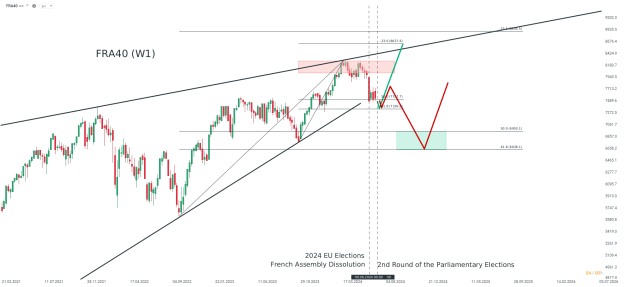On the evening of the European elections, Marine le Pen and Jordan Bardella’s Rassemblement National (RN) came out on top with 31% of the votes.
Emmanuel Macron suddenly announced the dissolution of the National Assembly and scheduled the first round of new legislative elections on 30 June.
Against all expectations, the NUPES (alliance of the left), which had seemingly broken up for several months, managed to agree on a common programme and renamed itself the Nouveau Front Populaire (NFP).
On the other hand, Eric Ciotti, the president of the Républicains (traditional right-wing party) allied himself with the RN (considered as a far right-wing party) against the agreement of his own camp, which led to him being ostracized by his own party.
In this context, 33 million voters turned out last Sunday to cast their ballots in the French parliamentary elections. This was the highest turnout for a legislative election since 1997. Compared with the 2022 elections, the age groups that saw the biggest increase in attendance were 18-24 year-olds (+124%) and 25-34 year-olds (+60%). These were also the only two age groups to widely vote for the NFP (the left-wing party).
Although the RN came out on top in most of the 577 constituencies, this first round of legislative elections highlighted a France more politically divided than ever, with the emergence of around 300 triangular results (as a reminder, a triangular result is a situation in which three candidates advance to the second round because they receive more than 12.5% of the votes cast by those registered on the electoral roll).
In the vast majority of cases, this triangular situation involves a RN candidate coming in first place, followed by an NFP and Renaissance (presidential majority party) candidate alternating between second and third place.
The main focus for the second round is therefore to understand the tactics of the various parties to obtain a majority in the assembly, or at least to prevent the RN from obtaining an absolute one.
The uncertain outcome of a “barrage with holes”
Although the victory of the RN is not unprecedented in French elections, this is the first time it has ever come so close to taking power.
This is why, in the past, in order to prevent the RN from gaining access to Matignon, the other parties all used to form a united front against what they saw as a threat to republican and democratic values. But now they are faced with an ideological divide that threatens their ability to unite to form the usual “barrage against the far right”.
What are the prospects for the second round? The strategy proclaimed by the centrists and the left-wing alliance is that of mutual withdrawal in the constituencies where their candidate would have come to third place, to avoid dispersing votes in a triangular configuration.
This would deprive the RN of an absolute majority in parliament, which would then be made up of a relative RN majority and multiple opposition groups with a strong minority. In such a scenario, the President would potentially be forced to form a “technical” government, responsible for day-to-day affairs but incapable of carrying out major structural reforms.
However, two factors need to be taken into account. First, the presidential coalition has hinted that it will not withdraw its support for candidates from France Insoumise (LFI), which accounts for almost half of the NFP candidates who qualify for the second round. Secondly, the NFP has announced that it is only prone to withdraw its candidates in 3rd place.
This would mean that triangular results would logically be inevitable and in favor of the RN, potentially opening the door to our second scenario: the RN obtaining an absolute majority.
What consequences for the markets?
Although we can distinguish two main scenarios for the second round, in reality they share similar outcomes.
The first scenario would lead to the formation of a “technical” government that would be incapable of undertaking the major legislative projects needed to bring the deficit back within the bounds of European budgetary rules.
The paralysis of the Assembly could be enough for the rating agencies to lower the quality of French debt, which would weaken the interest rate environment and, by extension, the equity markets.
This situation could have a direct impact on the index of the French economy, known as the CAC 40. However, technically speaking, the index price is already at a major support corresponding to the 50% retracement of the last upward impulse on a weekly scale, i.e. 7,517.7 points. If this threshold was breached, a rebound would still be possible off the 61.8% retracement, i.e. 7,339.8 points, beyond which buyers could finally capitulate.
In the second case, the consequence would also be political instability affecting France’s rating, as the President of the Republic might want to declare a new dissolution in the event of an absolute majority for the RN. However, this would give the party a short year to partially implement a programme that has been widely criticized for worsening public debt, which would further increase the risk premium demanded by lenders of the French government.
The CAC 40 could then break through its support zone or fail to react immediately on the downside and stage a short upward rally, allowing sellers to materialize their directional conviction with a premium. Whether or not a recovery is seen, a wider retracement zone lies between 6,638.1 and 6,950.1 points.
To avoid coming dangerously close to a debt crisis, the only way out would paradoxically be for the President to install a minority government in the Assembly and to govern by using Article 49.3 (allowing to pass laws without consulting the parliament) or by applying Article 16 of the Constitution (conferring full powers to the President of the Republic).
This would be considered as a guarantee of political stability for the financial markets but would carry a widely unpopular democratic implication. But once again, this is a risky gamble with the Head of State running the risk of a censure motion or impeachment for himself.
CAC 40 chart (W1)

Technical scenarios of a relative majority for the Rassemblement National in green, and an absolute majority in red. Source: xStation5

